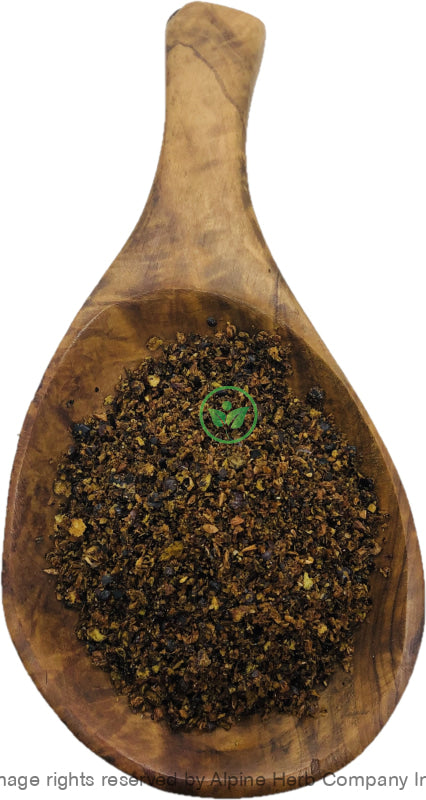Juniper Berry Cut Alpine Herb Company Inc.
$ 8,99 $ 5,39
Botanical Name: Juniperus communis
Common Name:
- English: Juniper Berry, Common Juniper
- Ayurvedic: Hapusha, Havushaa,Haauber, Matsyagandha.
- Unani: Abahal, Haauber, Hubb-ularar, Aarar
- Also, known as: Arar, Abahal, Habbul, Havuber, Havubair, Hapushaa, Havulber, Hosh, Padma Beeja, Palash, Hayusha, Wacholder, Genievre, Junipero, Ginepro, Kuli, Abhala, Habul hurer, Hanbera, Juniper bush, Ginepro, Enebro, Jenewerbessie, Kataja, Genievre, Wacholderbeeren, Ginepro, Junipa, Junipeo,Junipero, and Enbar.
Habitat: Europe and North America
Origin: Bosnia-Herzegovina
Harvested: Cultivated
Parts Used: Female cones
General Information:
Juniperus communis, an ornamental evergreen shrub or tree of the pine family, grows up to 30 feet with trees and shrubs of about forty species. The common Juniper is a smaller species, usually less than 25-30 feet tall, and many of its numerous varieties are less than 12 ft. The leaves are evergreen, stiff, sharp-pointed, flat, up to 2 cm long needles with relatively broad base, and glossy green lower surface, and bluish-green upper surface, open in whorls of three, are glaucous and concave above, keeled underneath. Flowers in May, with fleshy fruit of dark-purplish color, ripening in the second year after the flower, small, lacking perianth. Female and male flowers on different individuals. Female inflorescences yellowish-green, male flowers yellow. Borne in groups of three in the leaf axils. The female cones, “Juniper berries” are spherical, fleshy, berry-like, about 4-6 mm in diameter and dark purple-blue to black when ripe. They have a woody, resinous and turpentine-like aroma and a warm, pine-like taste. Male and female cones occur on separate plants. The cones take almost 18 months to ripen.
Juniper berries take two or three years to ripen, so that blue and green berries occur on the same plant. Only the blue, ripe berries are here picked. When collected in baskets or sacks, they are laid out on shelves to dry a little, during which process they lose some of the blue bloom and develop the blackish color seen in commerce. Juniper is used as a spice in European cuisine, mainly to flavor meat dishes. Juniper oil is used in confectionery, meat products, jellies and puddings. Every part of the shrub is medicinal, and the French peasantry prepare a sort of tar from the interior reddish wood of the trunk and branches.
How to use:
Decoctions are suitable for roots, barks, large seeds & berries, and other dense material. The simple way to make decoction is, in a saucepan, add 1 tablespoon of dried herbs to 1 cup of water. Bring the water to boil, reduce heat and simmer for 30-60 minutes. Strain and squeeze out as much as liquid as possible and enjoy!
Tips:
- You can sweeten your herbal decoctions with a bit of honey, natural fruit juice, stevia leaves powder and or licorice root powder.
Precautions:
You should consult with a qualified healthcare practitioner before using any herbal products, particularly if you are pregnant, nursing, or on any medications.
All information on this website is for educational purposes ONLY.
This information has not been evaluated by Health Canada.
This information is not intended to diagnose, treat, cure, or prevent any disease.
| Unit Size | 100g, 200g, 400g, 1kg |
|---|
Prompt shipping and expert packing
Thanks to our longstanding association with UPS FedEx DHL as well as other leading global carriers, we can offer a variety shipping options. Our warehouse staff is highly trained and will be able to pack your goods in accordance with our precise and exact specifications. Your items will go through an exhaustive examination before they will be securely packaged before being delivered. We ship to hundreds of thousands of customers daily in different countries. This is a sign of our determination to become the largest online retailer worldwide. Warehouses and distribution centers are located throughout Europe as well as in the USA.
Note that orders containing multiple items are processed according to the particular item.
We will thoroughly inspect all items ordered before shipping. Most orders are shipped within 48 hours. The delivery time will be between 3 and 7 working days.
Returns
The stock market is always changing. It's not entirely managed by us since we're involved with several entities, including the factory and the storage. Therefore, the actual inventory could fluctuate at any moment. Please be aware that it is possible that your order could be out of stock after you've placed your order.
Our policy lasts for 30 days. If it's been more than 30 days since the date you purchased your item We're sorry to say that we can't offer you a full exchange or refund.
You can only return a product if it is unused and still in the same state as when you received it. The item should be in the original packaging.


































